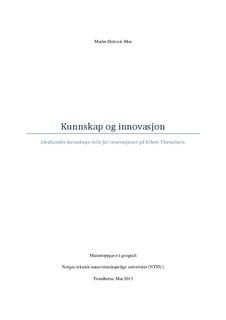| dc.contributor.advisor | Karlsen, Asbjørn | nb_NO |
| dc.contributor.author | Østtveit-Moe, Martin | nb_NO |
| dc.date.accessioned | 2014-12-19T14:26:31Z | |
| dc.date.available | 2014-12-19T14:26:31Z | |
| dc.date.created | 2013-10-10 | nb_NO |
| dc.date.issued | 2013 | nb_NO |
| dc.identifier | 655142 | nb_NO |
| dc.identifier.uri | http://hdl.handle.net/11250/265567 | |
| dc.description.abstract | The term path creation has contributed with nuances to the path perspective in evolutionary economic geography by its focus on agency and the relation between endogenous and exogenous agents. In this case-study I study the evolution of a path at Elkem Thamshavn by looking at how the plant has developed an advanced system for energy recovery and changed their end product from ferrosilicon to metallurgical silicon.
By emphasizing the local competency and the abilities of the plant to influence its path evolution, knowledge, learning and the ability to innovate are important subjects to study in the evolutionary perspective in economic geography. The main research question in this study focuses on: what is the role of place-bound knowledge for innovation processes?
This study has shown that the place-specific knowledge is important in the processes of change. It also acknowledges how the perspectives of path creation include agency and the agent’s capability to influence emergent events. This evolutionary approach has proven a fruitful analytical tool to explain the path development of firms, but the concept is in need of clarifications about the exogenous shock and the boundaries between endogenous and exogenous contributions. The exogenous shock can be seen as stimulator of change, but the innovations and path creation seen in this study would not be possible without the contributions of the endogenous agent, the plant itself. Both the corporate culture and the place-specific knowledge are important to see the possibilities of improvement and to be capable of implementing change.
Either as exogenous shocks or trough partners, knowledge and technology has been added to the firms existing knowledge thus facilitating new developments. The innovation processes could not been implemented or followed through without both an absorptive capacity internally at the plant and a culture to tackle various challenging consequences of innovations. A dichotomy between external and internal is also an artificial boundary as development processes must be seen as a cooperative and the changes develop through the relations between the exogenous and the endogenous. In the plant there exist a strong culture and perspective on their own knowledge and possibilities. This does not necessarily correlate to the TNCs perspectives, of which the plant is a part, although they both have the best interest of the firms at heart. | nb_NO |
| dc.language | nor | nb_NO |
| dc.publisher | Norges teknisk-naturvitenskapelige universitet, Fakultet for samfunnsvitenskap og teknologiledelse, Geografisk institutt | nb_NO |
| dc.title | Kunnskap og innovasjon: Stedbunden kunnskaps rolle for innovasjoner på Elkem Thamshavn | nb_NO |
| dc.type | Master thesis | nb_NO |
| dc.contributor.department | Norges teknisk-naturvitenskapelige universitet, Fakultet for samfunnsvitenskap og teknologiledelse, Geografisk institutt | nb_NO |
